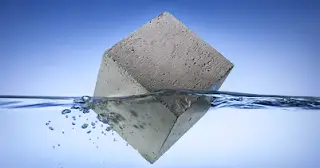Structural light weight concrete is defined as :-
Concrete made with lightweight aggregate; the aid-dried unit weight at 28 days is usually in the range of 90 to 115 lb/ft3 (1440 to 1850 kg/m3) and compressive strength is more than 2500 psi.
During the 1950s many multistory structures were designed from the foundations up, taking advantage of reduced dead weight using lightweight concrete. Examples are the 42 story Prudential Life Building in Chicago, which incorporated lightweight concrete floors, and the 18 story Statler Hilton Hotel in Dallas, which was designed with a light-weight concrete frame and flat plate floors.
Economy
Use of lightweight aggregate concrete in a structure is usually predicted on lower overall costs. While lightweight concrete may cost more per cubic yard than normal weight concrete, the structure may cost less as a result of reduced dead weight and lower foundation costs.
This is the basic reason, in most cases, for using structural lightweight concrete. Economy then depends on attaining a proper balance among cost of concrete per volume, unit weight and structural properties.
In all cases the light weight aggregates used in structural concrete are light in weight due to the cellular structure of individual aggregate particles. This cellular structure within the particles is formed at high temperatures, generally 2000 F or higher
Raw materials used in commercial production of structural lightweight aggregates are generally
a. Suitable natural deposits of shales, clays or slates
b. By products of other industries such as iron blast furnace slags.
Reparation of raw materials can range from negligible to extensive prior to treatment to produce expansion. In many cases crushing to suitable sizes is the only prerequisite. In the cases of finely divided materials such as silty and laminar clays, and fly ash, the raw material may need to be agglomerated with water, or possibly require addition of supplementary binder, fuel, gas-forming or fluxing agents, prior to heating.
Like Us on Facebook!
Production
Several different methods are used to produce structural lightweight aggregates, and the aggregates produced may vary widely in their characteristics. Process such as rotary kiln process is widely used throughout the world for the production of light weight aggregates.
Subscribe Us on YouTube!
Basically, the rotary kiln is a long, nearly horizontal cylinder lined with refractory materials. Raw material is introduced in a continuous stream at the upper end, and due to slow rotation and slope of the kiln, it progress to the lower or burner end. The heat causes simultaneous formation of gases and onset of a pyroplastic condition in the material. The viscosity of the softened mass is sufficient to entrap the gases and to form an internal cellular surface. This structure is retained on cooling as a vitrified hard material.
Sometimes the bloated material is discharged, cooled, and then crushed and screened to required aggregate gradation. The resultant particles tend to be cubical or angular in the shop and to have a varying percentage or particles with a smooth shell.
Properties of light weight aggregate
Particle Shape and Surface Texture : shape may be cubical, essentially rounded or angular and irregular. Surface texture may vary from smooth to small exposed pores
Bulk specific gravity – lower than normal weight aggregate – generally around 1/3 to 2/3 of that of normal weight aggregate
Unit weight – is significantly lower, due to cellular structure.
Strength – may be strong and hard and may be weak and friable – no correlation between aggregate strength and concrete strength
Moisture content and absorption – light weight aggregate tend to absorb more water due to cellular structure – light weight aggregate generally absorb from 5 to 20 percent by weight of dry aggregate.
Properties of light weight concrete
Compressive Strength – Normally vary between 3000 to 4000 psi and less frequently between 6000 psi and above
Unit weight – depends on unit weight of light weight aggregate and also proportion of the material while mixing – properties are mostly depending on unit weight thus very important
Slump – should be the lowest value consistent with the ability to satisfactorily place, consolidate and finish.
Entrained Air content – more air entrained and thus more durable against freeze and thaw etc.
Keywords includes
lightweight concrete pdf
how to make lightweight concrete
lightweight concrete blocks
lightweight concrete mix design
lightweight concrete wikipedia
lightweight concrete ppt
lightweight concrete mix
lightweight concrete properties
















